Multisensor Fault Diagnosis of Rolling Bearing with Noisy Unbalanced Data via Intuitionistic Fuzzy Weighted Least Squares Twin Support Higher-Order Tensor Machine
Abstract
1. Introduction
- This paper proposes a new tensor space nonlinear classifier called the IFW-LSTSHTM model. The classifier first designs two nonparallel classification hyperplanes in tensor space and solves a system of linear equations to improve computational efficiency. This classifier introduces regularization terms to achieve the principle of minimizing structural risk, and assigns penalty factors to samples of different categories to mitigate the impact of class imbalance.
- This paper proposes a global–local-based intuitionistic fuzzy membership score assignment scheme and a sample-weighting scheme based on prior information of intraclass local neighborhood structure. By assigning appropriate weights to each sample, the robustness of the model to noise and outliers is improved.
- Using FST time–frequency analysis to convert multisensor signals into time–frequency images can capture the spectral characteristics of multiple sensor signals that change over time. Then, the time–frequency images are reconstructed into feature tensors, which contain richer data structure information, better capture the relationships between multidimensional data, ensure the authenticity and integrity of sample patterns, improve the stability and certainty of the model, and provide an effective signal processing and representation method under variable working conditions.
- This paper derives a tensor kernel function with Tucker decomposition, which maps the decomposed core tensor and factor matrix of the feature tensor to a high-dimensional feature space, ensuring that the interaction relationships between components in different modes can be reflected during the nonlinear mapping process, thereby maximizing the preservation of the potential structural information of the feature tensor.
2. Related Work
2.1. Tensor Theory
2.2. Support Higher-Order Tensor Machine
3. Proposed Methods
3.1. Global–Local-Based IF Membership Score Assignment
3.2. IFW-LSTSHTM Model
| Algorithm 1 IFW-LSTSHTM |
| Input: Training samples , ; for , sample label , for , sample label ; Testing sample , parameters , , , , h, , . Output: Predicted label of . Step 1. Obtain approximate tensor samples for all training samples , by using tensor Tucker decomposition (23), and replace the original tensor samples with approximate tensor samples. Step 2. For , calculate , for linear kernel function, by using (27), for nonlinear kernel function, by using (26). Step 3. For , calculate and by using (12) and (14). Then calculate and by using (19) and (20); Step 4. For , substitute , , , and into (13) to obtain membership degree , and then substitute into (15) to obtain nonmembership degree . Step 5. Obtain the score of the positive class samples and the score of the negative class samples by using (16). Step 6. Calculate and , for linear kernel function, by using (33) and (34), for nonlinear kernel function, by using (31) and (32). Step 7. Obtain intraclass weight matrices of positive class and negative class , by using (41)–(43). Step 8. Obtain positive class imbalance penalty factor and negative class imbalance penalty factor by using (44). Step 9. Let , , , , and obtain the optimal solutions , for the first hyperplane by using (55). Step 10. Let , , , , obtain the solutions , for the second hyperplane by using (58). Step 11. Calculate by Step 2. Obtain the predicted label of test sample by decision rule (59). |
4. Feature Tensor Reconstruction
5. Case Studies
5.1. Case Study 1
5.1.1. Dataset Description and Settings
5.1.2. Experiment Results and Analysis
5.2. Case Study 2
5.2.1. Dataset Description and Settings
5.2.2. Experiment Result and Analysis
6. Conclusions
Author Contributions
Funding
Institutional Review Board Statement
Informed Consent Statement
Data Availability Statement
Conflicts of Interest
References
- Chi, H.; Chen, H. Research on Rolling Bearing Fault Diagnosis Method Based on MPE and Multi-Strategy Improved Sparrow Search Algorithm Under Local Mean Decomposition. Machines 2025, 13, 336. [Google Scholar] [CrossRef]
- Yuan, B.; Lei, L.; Chen, S. Optimized Variational Mode Decomposition and Convolutional Block Attention Module-Enhanced Hybrid Network for Bearing Fault Diagnosis. Machines 2025, 13, 320. [Google Scholar] [CrossRef]
- Wang, S.; Qiu, S.; Sun, Z.; Hsieh, T.H.; Qian, F.; Xiao, Y. Single-View 3D Object Perception Based on Vessel Generative Adversarial Network for Autonomous Ships. IEEE Trans. Intell. Transp. Syst. 2024, 25, 9238–9252. [Google Scholar] [CrossRef]
- Yu, Y.; Karimi, H.R.; Gelman, L.; Cetin, A.E. MSIFT: A novel end-to-end mechanical fault diagnosis framework under limited & imbalanced data using multi-source information fusion. Expert Syst. Appl. 2025, 274, 126947. [Google Scholar]
- Zhang, Y.F.; Han, B.; Han, M. A Novel Distributed Data-Driven Strategy for Fault Detection of Multi-Source Dynamic Systems. IEEE Trans. Circuits Syst. II Express Briefs 2022, 69, 4379–4383. [Google Scholar] [CrossRef]
- Zhu, J.; Zhu, L. Fault Diagnosis for Imbalanced Datasets Based on Deep Convolution Fuzzy System. Machines 2025, 13, 326. [Google Scholar] [CrossRef]
- Huang, Y.; Huang, W.; Hu, X.; Liu, Z.; Huo, J. UDDGN: Domain-Independent Compact Boundary Learning Method for Universal Diagnosis Domain Generation. IEEE Trans. Instrum. Meas. 2025, 74, 3531220. [Google Scholar] [CrossRef]
- Shen, C.; Wang, X.; Wang, D.; Li, Y.; Zhu, J.; Gong, M. Dynamic Joint Distribution Alignment Network for Bearing Fault Diagnosis Under Variable Working Conditions. IEEE Trans. Instrum. Meas. 2021, 70, 3510813. [Google Scholar] [CrossRef]
- Liu, M.R.; Sun, T.; Sun, X.M. Brain-Inspired Spike Echo State Network Dynamics for Aero-Engine Intelligent Fault Prediction. IEEE Trans. Instrum. Meas. 2023, 72, 3516313. [Google Scholar] [CrossRef]
- Tang, Y.; Zhang, C.; Wu, J.; Xie, Y.; Shen, W.; Wu, J. Deep Learning-Based Bearing Fault Diagnosis Using a Trusted Multiscale Quadratic Attention-Embedded Convolutional Neural Network. IEEE Trans. Instrum. Meas. 2024, 73, 3513215. [Google Scholar] [CrossRef]
- Mao, Z.; Wang, H.; Jiang, B.; Xu, J.; Guo, H. Graph Convolutional Neural Network for Intelligent Fault Diagnosis of Machines via Knowledge Graph. IEEE Trans. Ind. Inform. 2024, 20, 7862–7870. [Google Scholar] [CrossRef]
- Yu, Y.; He, Y.; Karimi, H.R.; Gelman, L.; Cetin, A.E. A two-stage importance-aware subgraph convolutional network based on multi-source sensors for cross-domain fault diagnosis. Neural Netw. 2024, 179, 106518. [Google Scholar] [CrossRef]
- Liao, X.; Wang, D.; Qiu, S.; Ming, X. ReDBN: An Interpretable Deep Belief Network for Fan Fault Diagnosis in Iron and Steel Production Lines. IEEE/ASME Trans. Mechatronics 2024, 1–12. [Google Scholar] [CrossRef]
- Qian, Q.; Zhang, B.; Li, C.; Mao, Y.; Qin, Y. Federated transfer learning for machinery fault diagnosis: A comprehensive review of technique and application. Mech. Syst. Signal Process. 2025, 223, 111837. [Google Scholar] [CrossRef]
- Li, Y.; Xu, X.; Hu, L.; Sun, K.; Han, M. A centroid contrastive multi-source domain adaptation method for fault diagnosis with category shift. Measurement 2025, 248, 116801. [Google Scholar] [CrossRef]
- Rezvani, S.; Wang, X.; Pourpanah, F. Intuitionistic Fuzzy Twin Support Vector Machines. IEEE Trans. Fuzzy Syst. 2019, 27, 2140–2151. [Google Scholar] [CrossRef]
- Sun, B.; Liu, X. Significance Support Vector Machine for High-Speed Train Bearing Fault Diagnosis. IEEE Sensors J. 2023, 23, 4638–4646. [Google Scholar] [CrossRef]
- Han, T.; Zhang, L.; Yin, Z.; Tan, A.C. Rolling bearing fault diagnosis with combined convolutional neural networks and support vector machine. Measurement 2021, 177, 109022. [Google Scholar] [CrossRef]
- Rezvani, S.; Wang, X. Intuitionistic fuzzy twin support vector machines for imbalanced data. Neurocomputing 2022, 507, 16–25. [Google Scholar] [CrossRef]
- Tanveer, M.; Tiwari, A.; Choudhary, R.; Jalan, S. Sparse pinball twin support vector machines. Appl. Soft Comput. 2019, 78, 164–175. [Google Scholar] [CrossRef]
- He, H.; Tan, Y.; Zhang, W. A wavelet tensor fuzzy clustering scheme for multi-sensor human activity recognition. Eng. Appl. Artif. Intell. 2018, 70, 109–122. [Google Scholar] [CrossRef]
- He, H.; Tan, Y.; Xing, J. Unsupervised classification of 12-lead ECG signals using wavelet tensor decomposition and two-dimensional Gaussian spectral clustering. Knowl.-Based Syst. 2019, 163, 392–403. [Google Scholar] [CrossRef]
- Ge, M.; Lv, Y.; Ma, Y. Research on Multichannel Signals Fault Diagnosis for Bearing via Generalized Non-Convex Tensor Robust Principal Component Analysis and Tensor Singular Value Kurtosis. IEEE Access 2020, 8, 178425–178449. [Google Scholar] [CrossRef]
- Hao, Z.; He, L.; Chen, B.; Yang, X. A Linear Support Higher-Order Tensor Machine for Classification. IEEE Trans. Image Process. 2013, 22, 2911–2920. [Google Scholar]
- He, Z.; Shao, H.; Cheng, J.; Zhao, X.; Yang, Y. Support tensor machine with dynamic penalty factors and its application to the fault diagnosis of rotating machinery with unbalanced data. Mech. Syst. Signal Process. 2020, 141, 106441. [Google Scholar] [CrossRef]
- Ma, Z.; Yang, L.T.; Zhang, Q. Support multimode tensor machine for multiple classification on industrial big data. IEEE Trans. Ind. Inform. 2020, 17, 3382–3390. [Google Scholar] [CrossRef]
- Ding, W.; Zhou, T.; Huang, J.; Jiang, S.; Hou, T.; Lin, C.T. FMDNN: A Fuzzy-Guided Multigranular Deep Neural Network for Histopathological Image Classification. IEEE Trans. Fuzzy Syst. 2024, 32, 4709–4723. [Google Scholar] [CrossRef]
- Sun, T.; Sun, X.M. New Results on Classification Modeling of Noisy Tensor Datasets: A Fuzzy Support Tensor Machine Dual Model. IEEE Trans. Syst. Man Cybern. Syst. 2022, 52, 5188–5200. [Google Scholar] [CrossRef]
- Yang, C.; Jia, M. Hierarchical multiscale permutation entropy-based feature extraction and fuzzy support tensor machine with pinball loss for bearing fault identification. Mech. Syst. Signal Process. 2021, 149, 107182. [Google Scholar] [CrossRef]
- Rezvani, S.; Wang, X. Class imbalance learning using fuzzy ART and intuitionistic fuzzy twin support vector machines. Inf. Sci. 2021, 578, 659–682. [Google Scholar] [CrossRef]
- Liang, Z.; Zhang, L. Intuitionistic fuzzy twin support vector machines with the insensitive pinball loss. Appl. Soft Comput. 2022, 115, 108231. [Google Scholar] [CrossRef]
- Zhang, Y.; Han, B.; Han, M. Mechanical Fault Diagnosis with Noisy Multisource Signals via Unified Pinball Loss Intuitionistic Fuzzy Support Tensor Machine. IEEE Trans. Ind. Inform. 2024, 20, 62–72. [Google Scholar] [CrossRef]
- Yang, C.; He, Q.; Li, Z.; Jia, M.; Gabbouj, M.; Peng, Z. Multichannel Fault Diagnosis of Planetary Gearbox via Difference-Average Symbol Transition Entropy and Twin Support Higher-Order Tensor Machine. IEEE Trans. Instrum. Meas. 2024, 73, 3507210. [Google Scholar] [CrossRef]
- Gundewar, S.K.; Kane, P.V. Bearing fault diagnosis using time segmented Fourier synchrosqueezed transform images and convolution neural network. Measurement 2022, 203, 111855. [Google Scholar] [CrossRef]
- Kolda, T.G.; Bader, B.W. Tensor Decompositions and Applications. SIAM Rev. 2009, 51, 455–500. [Google Scholar] [CrossRef]
- Zhao, C.; Zio, E.; Shen, W. Domain generalization for cross-domain fault diagnosis: An application-oriented perspective and a benchmark study. Reliab. Eng. Syst. Saf. 2024, 245, 109964. [Google Scholar] [CrossRef]
- Jung, W.; Kim, S.H.; Yun, S.H.; Bae, J.; Park, Y.H. Vibration, acoustic, temperature, and motor current dataset of rotating machine under varying operating conditions for fault diagnosis. Data Brief 2023, 48, 109049. [Google Scholar] [CrossRef]
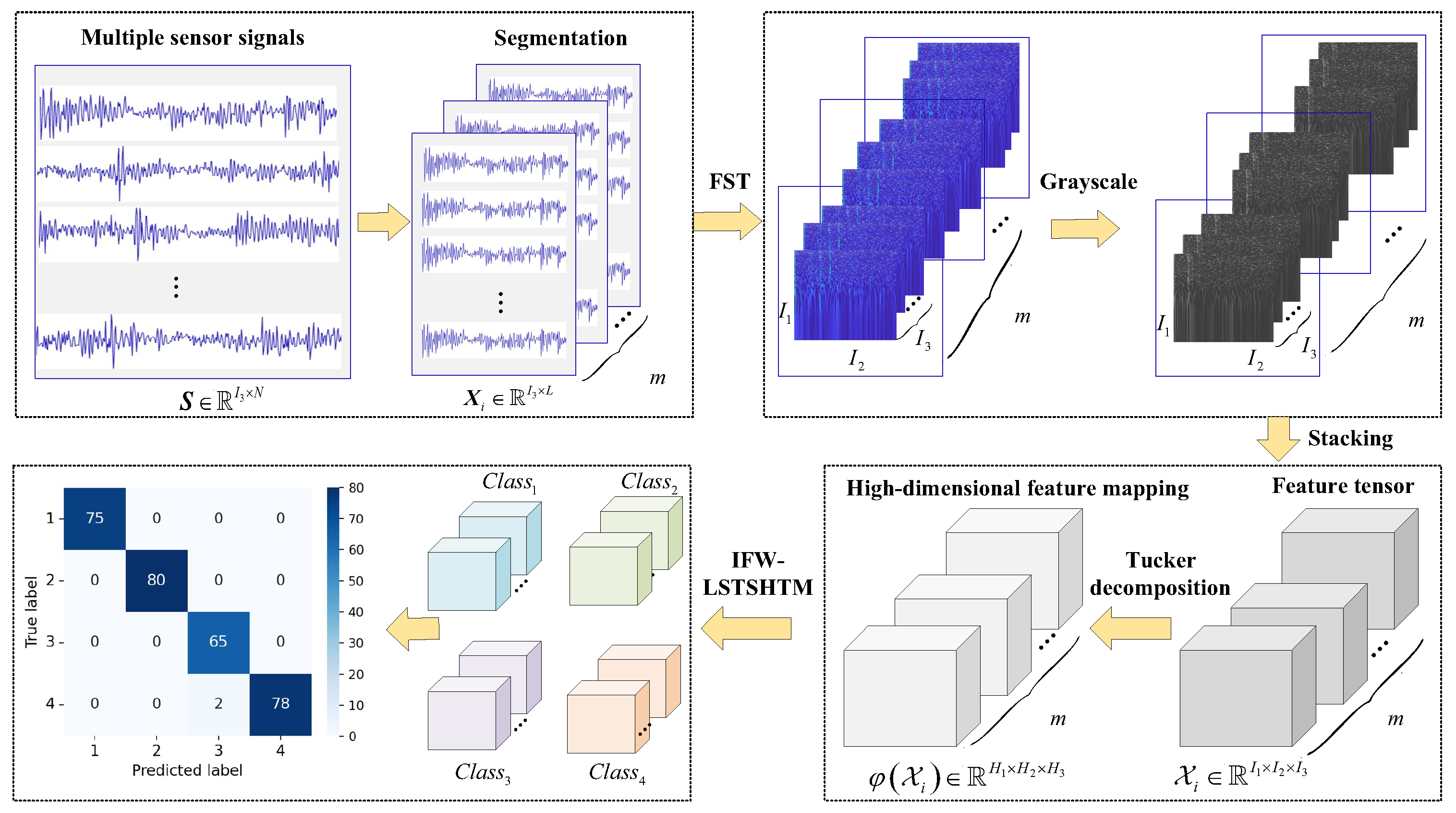
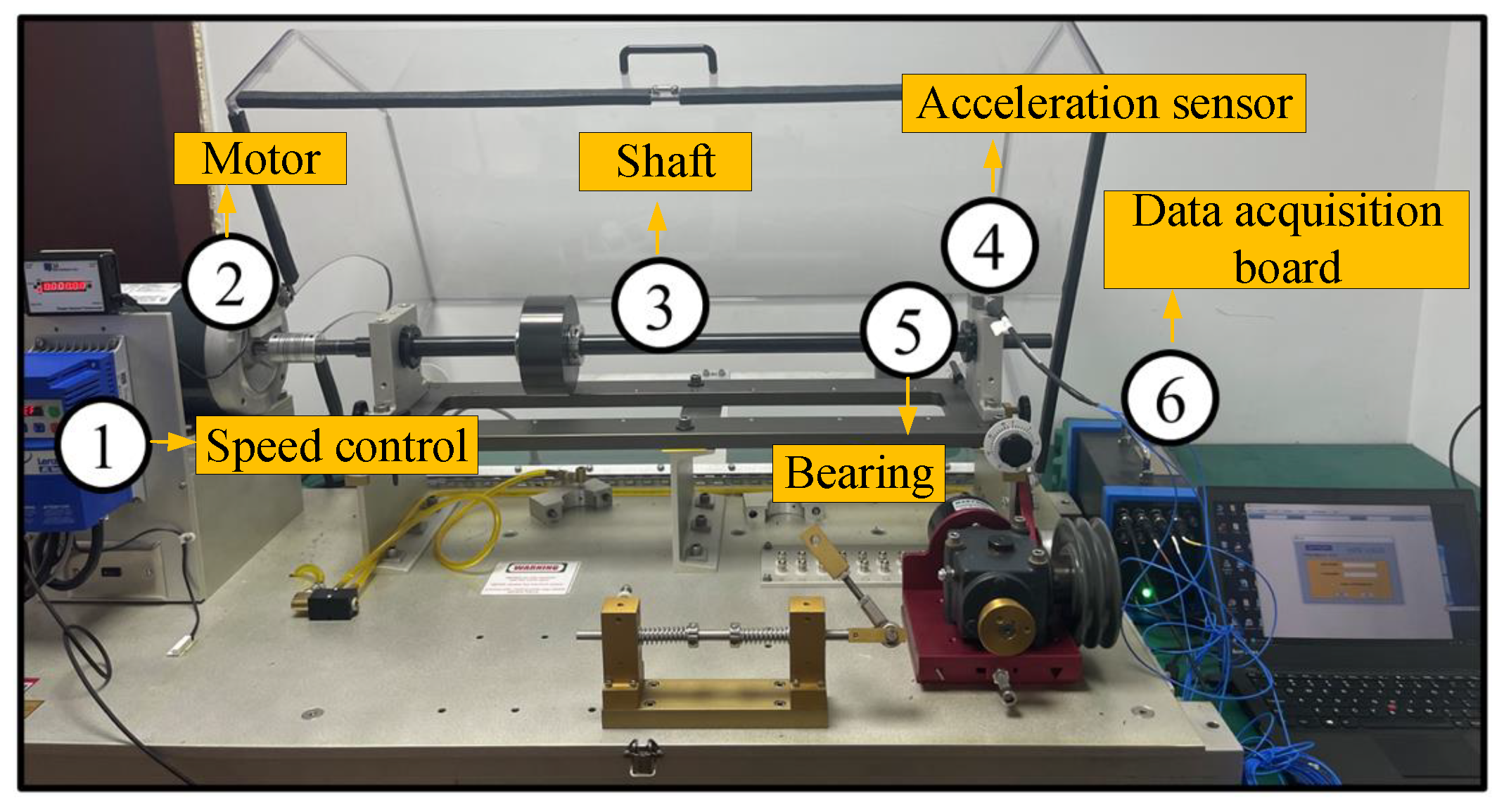

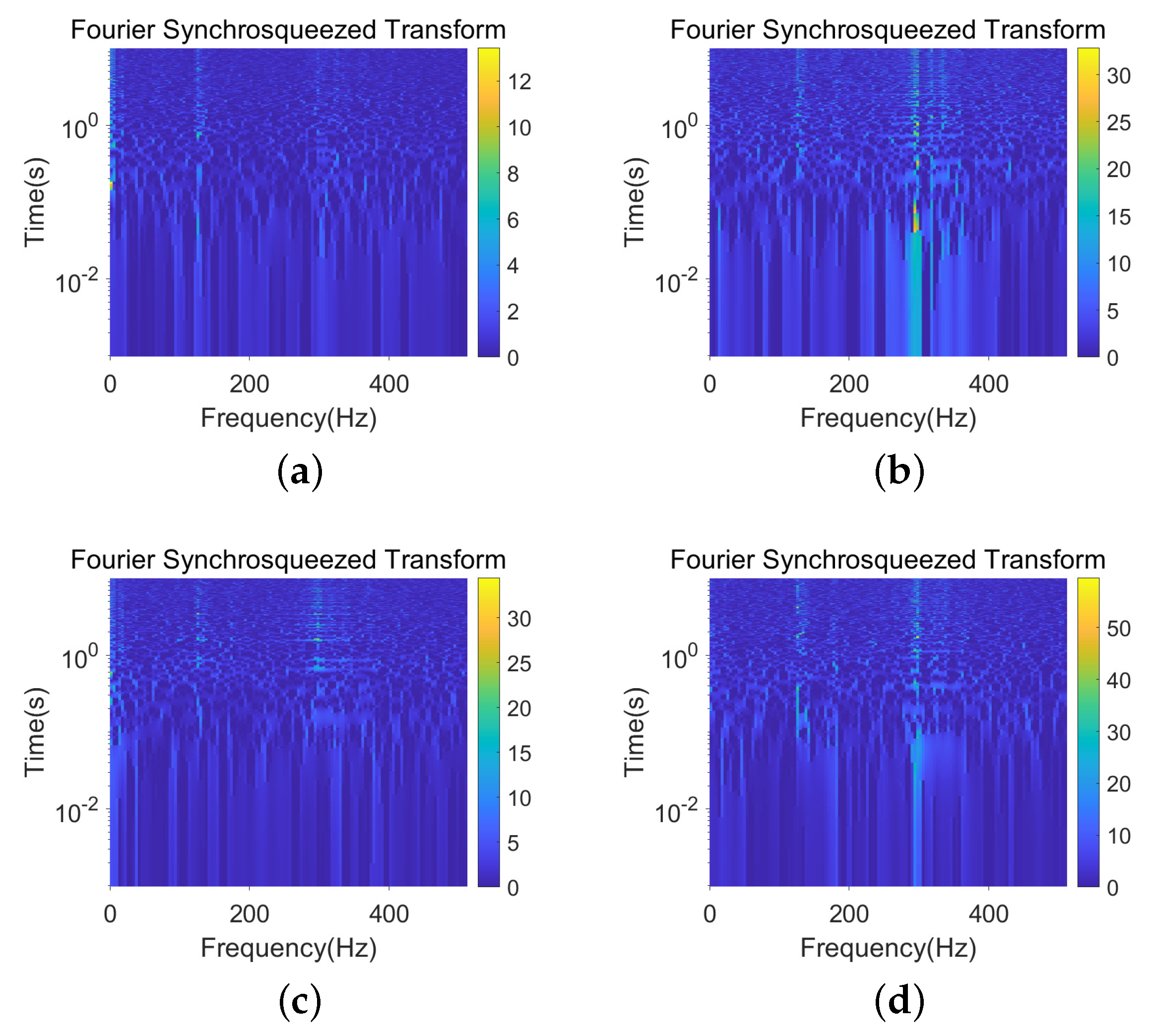
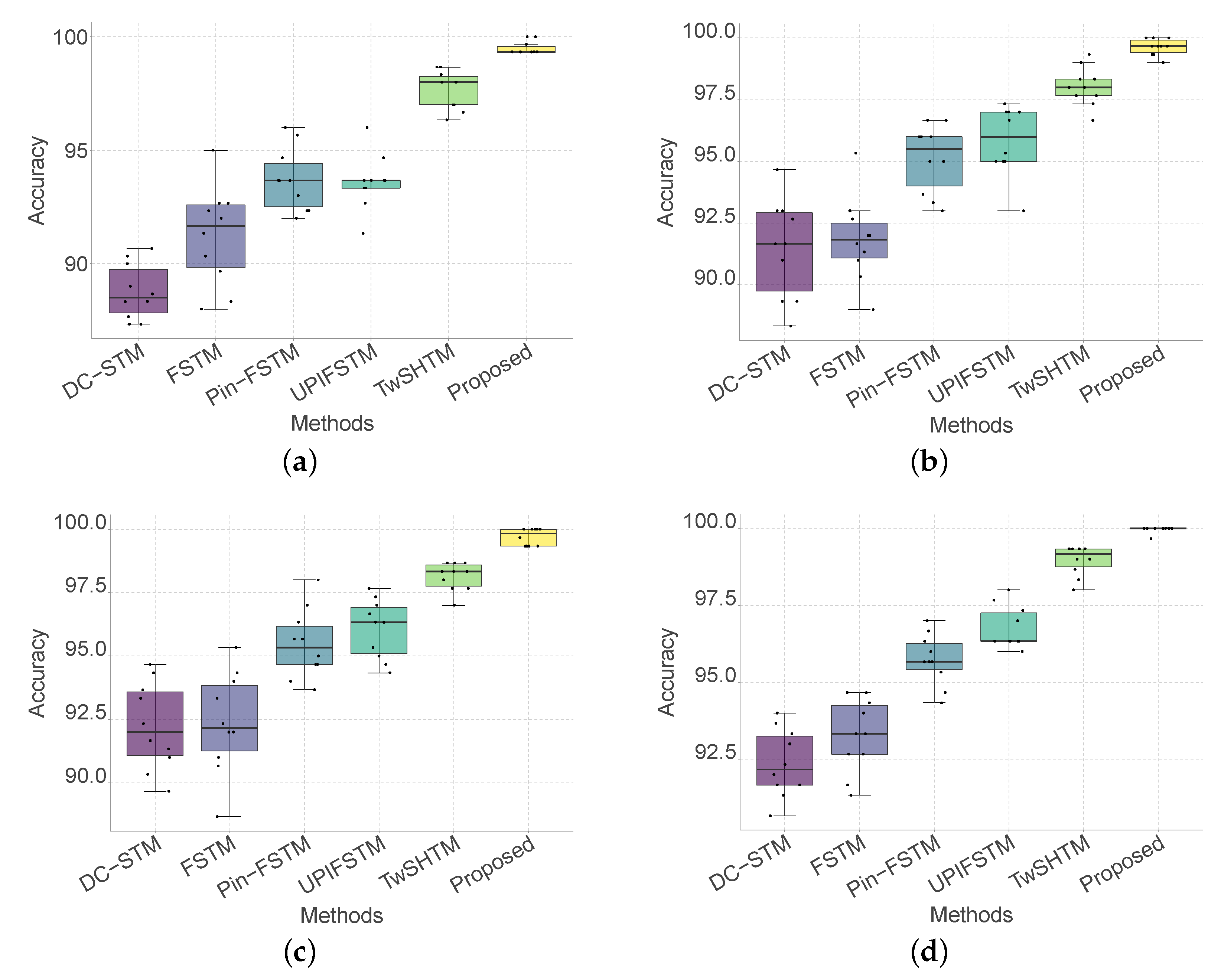


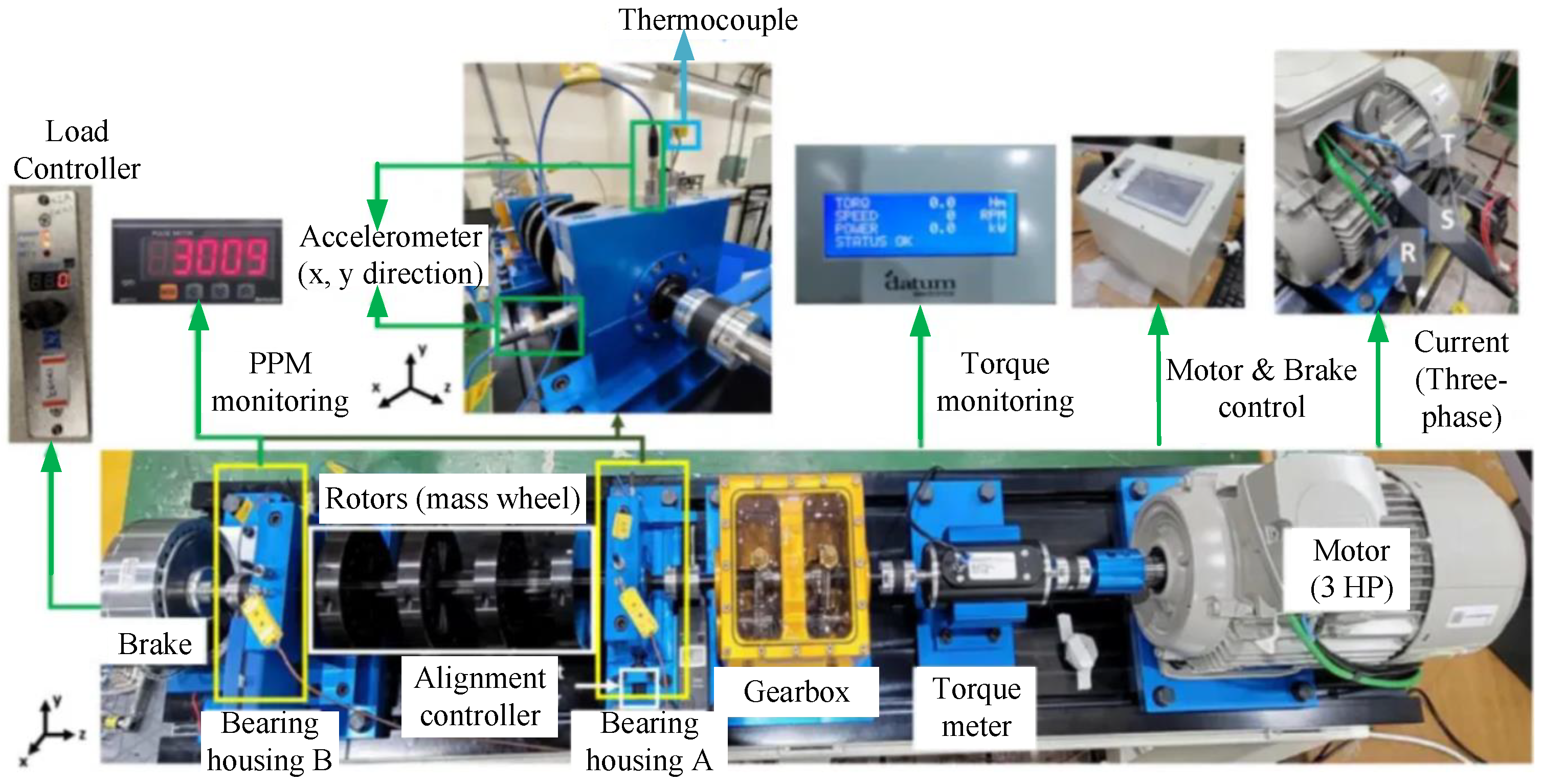

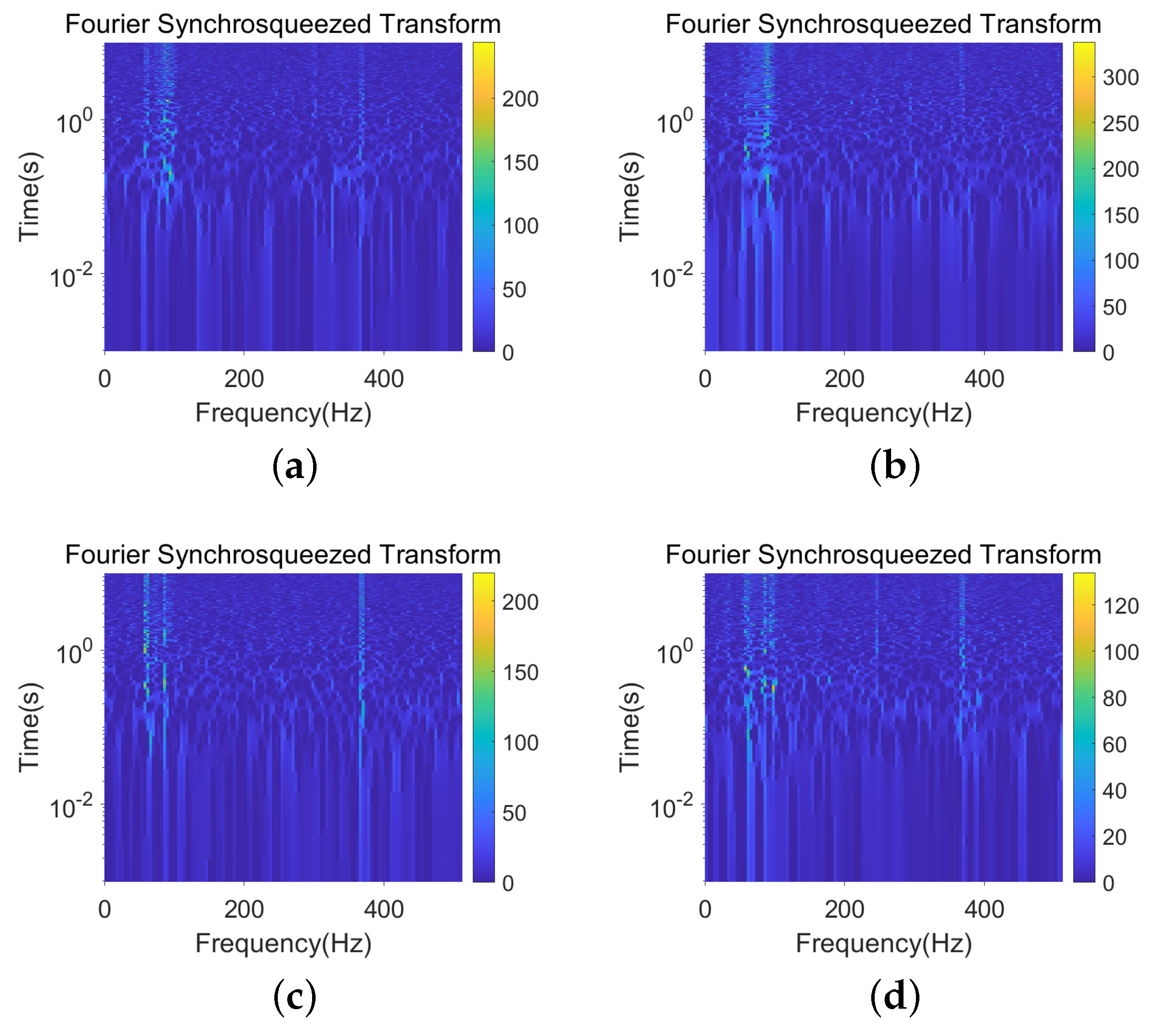
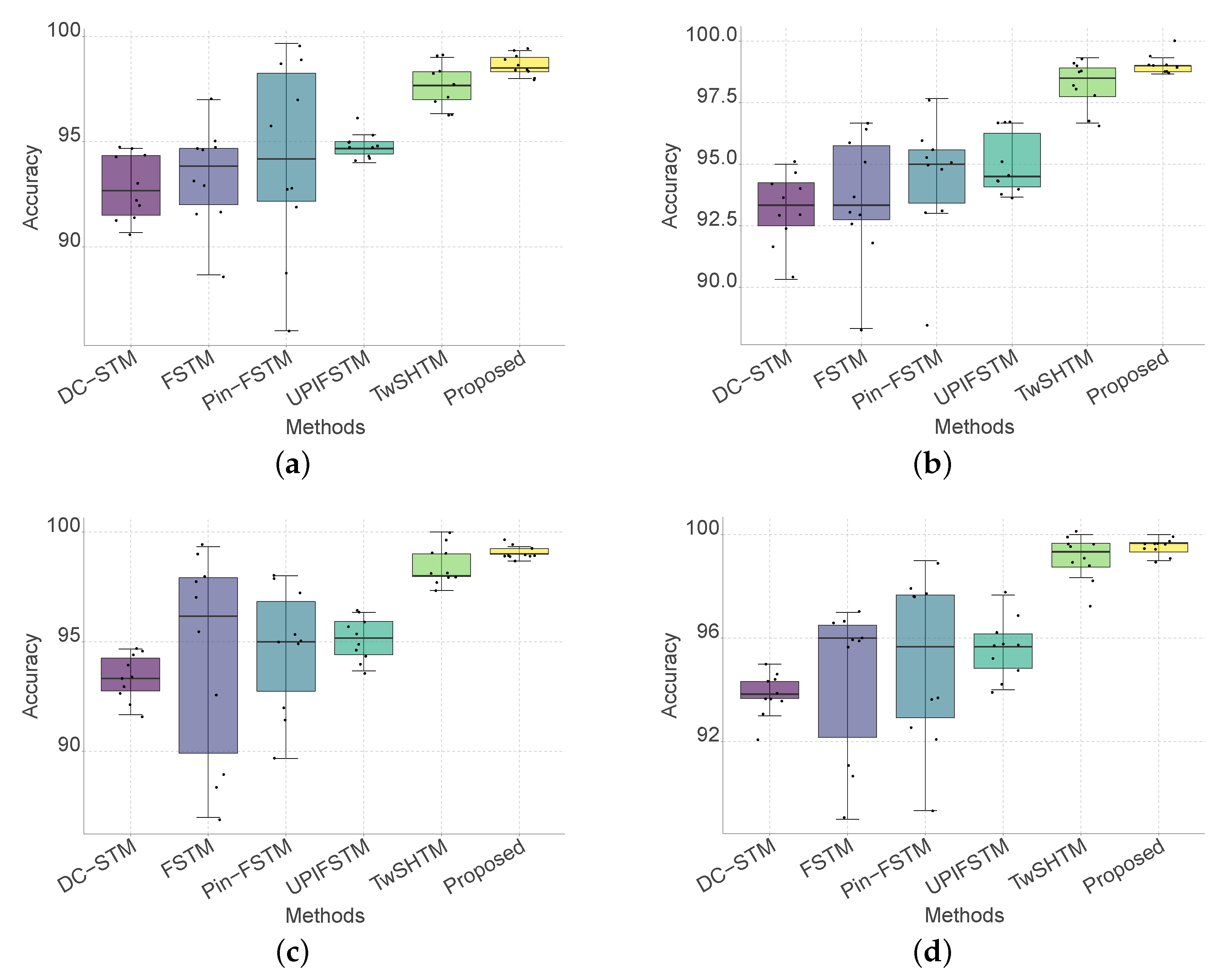
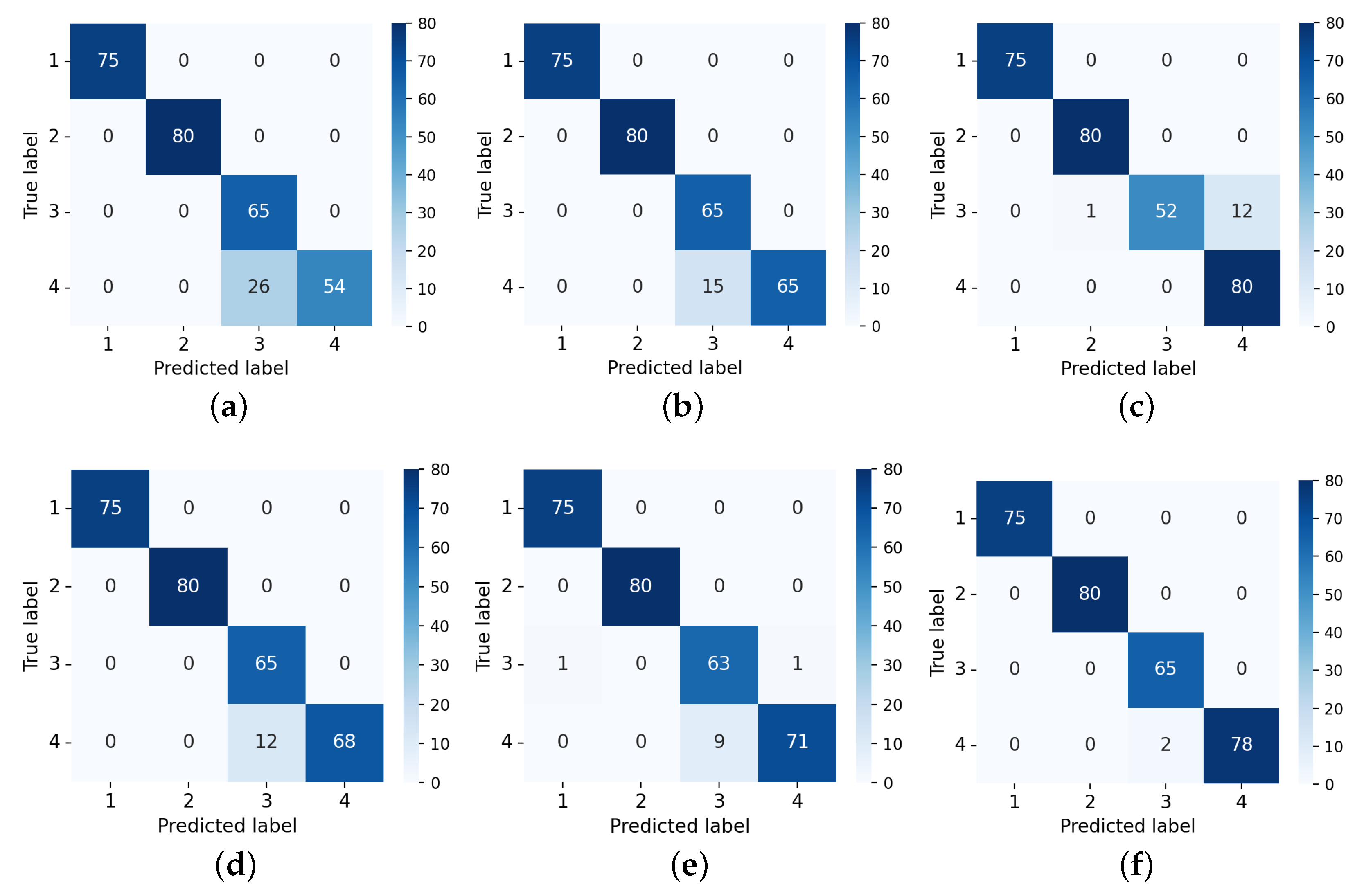
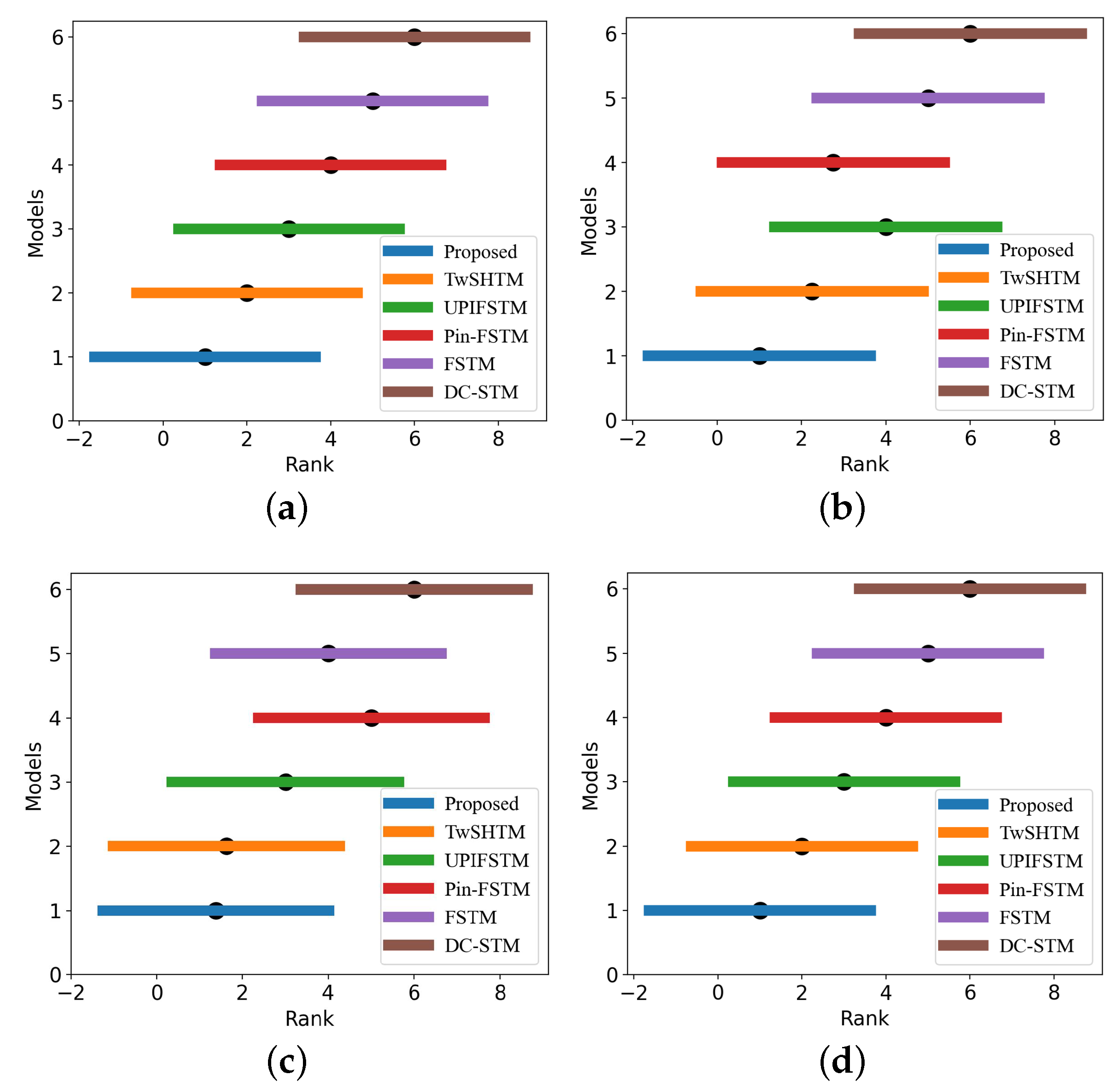
| Label | Status Description | Train Number | Test Number |
|---|---|---|---|
| 1 | Ball fault | 150 | 75 |
| 2 | Inner race fault | 150 | 80 |
| 3 | Outer race fault | 150 | 65 |
| 4 | Combination fault | 150 | 80 |
| Confusion Matrix | Predicted Value | ||
|---|---|---|---|
| Positive | Negative | ||
| Actual value | Positive | TP | FN |
| Negative | FP | TN | |
| Model | SNR | Accuracy | Precision | Recall | F-Score |
|---|---|---|---|---|---|
| DC-STM | 1 | 88.77 ± 1.16 | 91.54 ± 0.85 | 89.26 ± 1.12 | 88.66 ± 1.27 |
| 2 | 91.47 ± 1.89 | 92.30 ± 1.70 | 91.59 ± 1.90 | 91.54 ± 1.88 | |
| 3 | 92.23 ± 1.63 | 93.28 ± 1.30 | 92.38 ± 1.64 | 92.33 ± 1.62 | |
| 4 | 92.37 ± 1.04 | 93.28 ± 0.83 | 92.35 ± 1.08 | 92.44 ± 1.05 | |
| FSTM | 1 | 91.23 ± 2.06 | 93.02 ± 1.37 | 91.50 ± 1.94 | 91.25 ± 2.12 |
| 2 | 91.83 ± 1.60 | 92.86 ± 1.26 | 91.84 ± 1.58 | 91.93 ± 1.56 | |
| 3 | 92.37 ± 1.87 | 92.93 ± 1.68 | 92.36 ± 1.88 | 92.42 ± 1.83 | |
| 4 | 93.27 ± 1.12 | 94.00 ± 0.89 | 93.37 ± 1.13 | 93.37 ± 1.13 | |
| Pin-FSTM | 1 | 93.70 ± 1.31 | 94.23 ± 1.18 | 93.46 ± 1.39 | 93.65 ± 1.36 |
| 2 | 95.13 ± 1.30 | 95.46 ± 1.19 | 95.13 ± 1.34 | 95.22 ± 1.32 | |
| 3 | 95.47 ± 1.28 | 95.77 ± 1.14 | 95.40 ± 1.29 | 95.52 ± 1.24 | |
| 4 | 95.73 ± 0.79 | 96.16 ± 0.64 | 95.63 ± 0.83 | 95.81 ± 0.77 | |
| UPIFSTM | 1 | 93.60 ± 1.14 | 94.00 ± 1.00 | 93.66 ± 1.11 | 93.67 ± 1.11 |
| 2 | 95.83 ± 1.32 | 96.11 ± 1.18 | 95.82 ± 1.31 | 95.91 ± 1.27 | |
| 3 | 96.07 ± 1.10 | 96.28 ± 1.06 | 96.11 ± 1.11 | 96.15 ± 1.10 | |
| 4 | 96.77 ± 0.65 | 97.03 ± 0.59 | 96.75 ± 0.61 | 96.86 ± 0.61 | |
| TwSHTM | 1 | 97.67 ± 0.80 | 97.78 ± 0.73 | 97.72 ± 0.76 | 97.71 ± 0.77 |
| 2 | 98.03 ± 0.74 | 98.12 ± 0.70 | 98.09 ± 0.74 | 98.07 ± 0.73 | |
| 3 | 98.13 ± 0.52 | 98.22 ± 0.50 | 98.24 ± 0.50 | 98.19 ± 0.51 | |
| 4 | 98.97 ± 0.46 | 99.00 ± 0.43 | 99.02 ± 0.43 | 99.00 ± 0.43 | |
| Proposed | 1 | 99.50 ± 0.27 | 99.48 ± 0.28 | 99.50 ± 0.27 | 99.48 ± 0.28 |
| 2 | 99.63 ± 0.31 | 99.64 ± 0.31 | 99.63 ± 0.31 | 99.63 ± 0.31 | |
| 3 | 99.70 ± 0.31 | 99.69 ± 0.32 | 99.71 ± 0.31 | 99.70 ± 0.32 | |
| 4 | 99.97 ± 0.10 | 99.97 ± 0.09 | 99.96 ± 0.12 | 99.97 ± 0.10 |
| Label | Status Description | Train Number | Test Number |
|---|---|---|---|
| 1 | Inner race fault | 150 | 75 |
| 2 | Outer race fault | 150 | 80 |
| 3 | Shaft misalignment fault | 150 | 65 |
| 4 | Rotor unbalance fault | 150 | 80 |
| Model | SNR | Accuracy | Precision | Recall | F-Score |
|---|---|---|---|---|---|
| DC-STM | 1 | 92.87 ± 1.46 | 93.86 ± 0.96 | 93.31 ± 1.37 | 92.60 ± 1.54 |
| 2 | 93.20 ± 1.38 | 94.07 ± 0.90 | 93.63 ± 1.29 | 92.95 ± 1.45 | |
| 3 | 93.37 ± 1.00 | 94.16 ± 0.68 | 93.78 ± 0.94 | 93.13 ± 1.05 | |
| 4 | 93.83 ± 0.82 | 94.48 ± 0.56 | 94.22 ± 0.77 | 93.61 ± 0.86 | |
| FSTM | 1 | 93.40 ± 2.11 | 94.26 ± 1.39 | 93.80 ± 1.97 | 93.14 ± 2.23 |
| 2 | 93.63 ± 2.40 | 94.45 ± 1.59 | 94.02 ± 2.24 | 93.38 ± 2.54 | |
| 3 | 94.33 ± 4.48 | 95.32 ± 3.12 | 94.67 ± 4.18 | 94.05 ± 4.74 | |
| 4 | 94.47 ± 2.84 | 95.04 ± 2.03 | 94.78 ± 2.68 | 94.24 ± 3.00 | |
| Pin-FSTM | 1 | 94.20 ± 4.36 | 95.89 ± 2.71 | 93.31 ± 5.03 | 93.39 ± 5.26 |
| 2 | 94.37 ± 2.39 | 95.74 ± 1.42 | 93.51 ± 2.76 | 93.80 ± 2.90 | |
| 3 | 94.67 ± 2.71 | 95.98 ± 1.73 | 93.86 ± 3.12 | 94.14 ± 3.14 | |
| 4 | 95.13 ± 3.10 | 96.06 ± 2.29 | 94.74 ± 3.23 | 94.79 ± 3.34 | |
| UPIFSTM | 1 | 94.80 ± 0.54 | 95.17 ± 0.41 | 95.13 ± 0.51 | 94.62 ± 0.56 |
| 2 | 94.97 ± 1.18 | 95.33 ± 0.92 | 95.28 ± 1.10 | 94.79 ± 1.22 | |
| 3 | 95.13 ± 0.91 | 95.28 ± 0.75 | 95.32 ± 0.83 | 94.97 ± 0.94 | |
| 4 | 95.63 ± 1.09 | 95.71 ± 0.99 | 95.79 ± 1.06 | 95.51 ± 1.12 | |
| TwSHTM | 1 | 97.67 ± 0.94 | 97.59 ± 0.92 | 97.79 ± 0.90 | 97.58 ± 0.97 |
| 2 | 98.20 ± 0.90 | 98.12 ± 0.86 | 98.31 ± 0.84 | 98.13 ± 0.93 | |
| 3 | 98.47 ± 0.85 | 98.38 ± 0.87 | 98.56 ± 0.80 | 98.41 ± 0.88 | |
| 4 | 99.13 ± 0.81 | 99.07 ± 0.84 | 99.19 ± 0.76 | 99.10 ± 0.84 | |
| Proposed | 1 | 98.63 ± 0.48 | 98.53 ± 0.50 | 98.66 ± 0.49 | 98.58 ± 0.50 |
| 2 | 99.03 ± 0.38 | 98.59 ± 0.41 | 99.07 ± 0.37 | 98.99 ± 0.39 | |
| 3 | 99.10 ± 0.26 | 99.05 ± 0.25 | 99.10 ± 0.30 | 99.06 ± 0.28 | |
| 4 | 99.50 ± 0.31 | 99.47 ± 0.34 | 99.50 ± 0.30 | 99.48 ± 0.32 |
| Models | DC-STM | FSTM | Pin-FSTM | UPIFSTM | TwSHTM | IFW-LSTSHTM |
|---|---|---|---|---|---|---|
| [25] | [28] | [29] | [32] | [33] | Proposed | |
| Input order | N-order | N-order | 2-order | 3-order | N-order | N-order |
| Imbalance problem | √ | × | × | × | × | √ |
| Number of planes | One | One | One | One | Two | Two |
| Computing efficiency | Low ↓ | Low ↓ | Low ↓ | Low ↓ | High ↑ | High ↑ |
| Noise insensitivity | × | √ | √ | √ | × | √ |
| Intuitionistic fuzzy | × | × | × | √ | × | √ |
| Global–local information | × | × | × | × | × | √ |
| Structural information | × | √ | × | × | × | √ |
| Decomposition method | CP | Tucker | × | × | CP | Tucker |
| Neighborhood information | × | × | × | × | × | √ |
Disclaimer/Publisher’s Note: The statements, opinions and data contained in all publications are solely those of the individual author(s) and contributor(s) and not of MDPI and/or the editor(s). MDPI and/or the editor(s) disclaim responsibility for any injury to people or property resulting from any ideas, methods, instructions or products referred to in the content. |
© 2025 by the authors. Licensee MDPI, Basel, Switzerland. This article is an open access article distributed under the terms and conditions of the Creative Commons Attribution (CC BY) license (https://creativecommons.org/licenses/by/4.0/).
Share and Cite
Dong, S.; Zhang, Y.; Wang, S. Multisensor Fault Diagnosis of Rolling Bearing with Noisy Unbalanced Data via Intuitionistic Fuzzy Weighted Least Squares Twin Support Higher-Order Tensor Machine. Machines 2025, 13, 445. https://doi.org/10.3390/machines13060445
Dong S, Zhang Y, Wang S. Multisensor Fault Diagnosis of Rolling Bearing with Noisy Unbalanced Data via Intuitionistic Fuzzy Weighted Least Squares Twin Support Higher-Order Tensor Machine. Machines. 2025; 13(6):445. https://doi.org/10.3390/machines13060445
Chicago/Turabian StyleDong, Shengli, Yifang Zhang, and Shengzheng Wang. 2025. "Multisensor Fault Diagnosis of Rolling Bearing with Noisy Unbalanced Data via Intuitionistic Fuzzy Weighted Least Squares Twin Support Higher-Order Tensor Machine" Machines 13, no. 6: 445. https://doi.org/10.3390/machines13060445
APA StyleDong, S., Zhang, Y., & Wang, S. (2025). Multisensor Fault Diagnosis of Rolling Bearing with Noisy Unbalanced Data via Intuitionistic Fuzzy Weighted Least Squares Twin Support Higher-Order Tensor Machine. Machines, 13(6), 445. https://doi.org/10.3390/machines13060445






